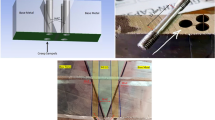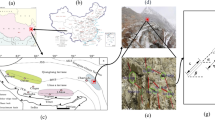Abstract
For structural integrity analysis of thin walled tubular components such as fuel claddings used in nuclear reactors, knowledge of valid fracture mechanics parameters are required. As axially-cracked thin tubes possess a non-standard geometry from the point of view of specimen fabrication, there is no direct straight forward way to derive their fracture mechanics parameters with known functions as can be done for standard test methods. In the present work, the J–R curve for an axially cracked fuel pin from Indian 220 MWe pressurized heavy water reactor is derived after experimental and analytical derivation of the required parameters and the results are compared with earlier published data for similar material.
Similar content being viewed by others
Abbreviations
- a :
-
Crack length
- \({{a}_0^\prime}\) :
-
Crack length at the start of the test
- \({a_{bi}^{\prime}}\) :
-
Blunting corrected crack size at the ith data point of the load-normalization method
- b 0 :
-
Initial unbroken ligament length of the PLT specimen
- A :
-
Cracked area of the PLT specimen fracture surface
- A uc :
-
Area of the remaining ligament or un-cracked area
- A el :
-
Elastic part of area under the load-displacement curve
- A pl :
-
Plastic part of area under the load-displacement curve
- C :
-
Compliance of the PLT specimens
- E :
-
Young’s modulus
- f(a/W):
-
Geometric shape function for evaluation of stress intensity factor as a function of a/W for a finite PLT specimen
- F L :
-
Limit load of the PLT specimens
- J :
-
J-integral
- J 0.2 :
-
J-integral corresponding to 0.2 mm crack growth
- J el :
-
Elastic part of J-integral
- J pl :
-
Plastic part of J-integral
- K I :
-
Mode-I stress intensity factor
- P i :
-
Load at step ‘i’ of the load-normalization process
- P Ni :
-
Normalized load at step ‘i’
- t :
-
Thickness of the PLT specimens
- v i :
-
Total displacement at step ‘i’
- v pli :
-
Plastic part of displacement at step ‘i’
- \({{v}^{\prime}_{Ni}}\) :
-
Normalized plastic part of displacement at step ‘i’
- W :
-
Width of the PLT test set up = 19 mm
- η, γ :
-
Geometric factors used in evaluation of the plastic part of the J-integral and crack growth correction respectively
- ν :
-
Poisson’s ratio
- σ Y :
-
Flow stress of the material
References
Arsène S, Bai J, Bompard P (2003) Hydride embrittlement and irradiation effects on the hoop mechanical properties of pressurized water reactor (PWR) and boiling-water reactor (BWR) Zircaloy cladding tubes: part III. Mechanical behavior of hydride in stress-relieved annealed and recrystallized Zircaloys at 20°C and 300°C. Metall Mater Trans 34A: 579–588
ASTM Standard E 1820-01 (2000) Standard test method for measurement of fracture toughness. ASTM, Philadelphia, PA, 03.01:1–21
Bertolino G, Meyer G, Ipiña JP (2002) Degradation of the mechanical properties of Zircaloy-4 due to hydrogen embrittlement. J Alloys Comp 330–332: 408–413
Bertolino G, Meyer G, Perez IJ (2003) Effects of hydrogen content and temperature on fracture toughness of Zircaloy-4. J Nucl Mater 320: 272–279
Bertolino G, Meyer G, Perez IJ (2003) In situ crack growth observation and fracture toughness measurement of hydrogen charged zircaloy-4. J Nucl Mater 322: 57–65
Bertsch J, Hoffelner W (2006) Crack resistance curve determination of tube cladding material. J Nucl Mater 352: 116–125
Chung H, Kassner T (1998) Cladding metallurgy and fracture behavior during reactivity-initiated accidents at high burnup. Nucl Eng Des 186: 411–427
Duggan TV, Proctor MW, Spence LJ (1979) Stress intensity calibrations and compliance functions for fracture toughness and crack propagation test specimens. Int J Fatigue 1(1): 37–47
Dzugan J, Viehrig HW (2004) Application of the normalization method for the determination of J–R curves. Mater Sci Eng A387–389: 307–311
Grigoriev V, Josefsson B, Lind A, Rosborg B (1995) A pin-loading tension test for evaluation of thin-walled tubular materials. Scr Metall Mater 33(1): 109–114
Grigoriev V, Jakobsson R (2005) Delayed hydrogen cracking velocity and J-integral measurements on irradiated BWR cladding. J ASTM Int 2(8): 1–16
Grigoriev V, Josefsson B, Rosborg B (1996) Fracture toughness of zircaloy cladding tubes. Zirconium in nuclear industry. In: Bradely ER, Sabol GP (eds) Proceedings of 11th international symposium. ASTM STP 1295, pp 431–447
Herrera R, Landes JD (1988) A direct J–R curve analysis of fracture toughness tests. J Test Eval 16(5): 427–449
Hoagland RG, Rowe RG (1969) Fracture of irradiated Zircaloy-2. J Nucl Mater 30: 179–195
Landes JD, Herrera R (1988) A new look at J–R curve analysis. Int J Fract 36: 9–14
Landes JD, Zhou Z, Lee K, Herrera R (1991) Normalization method for developing J–R curves with the LMN function. J Test Eval 19(4): 305–311
Leclercq S, Parrot A, Leroy M (2008) Failure characteristics of cladding tubes under RIA conditions. Nucl Eng Des 238(9): 2206–2218
Lee KW, Kim SK, Kim KT, Hong SI (2001) Ductility and strain rate sensitivity of Zircaloy-4 nuclear fuel claddings. J Nucl Mater 295: 21–26
Mani Krishna KV, Sahoo SK, Samajdar I, Neogy S, Tewari R, Srivastava D, Dey GK, Das GH, Saibaba N, Banarjee S (2008) J Nucl Mat 383: 78
Meyer RO, McCardell RK, Chung HM, Diamond DJ, Scott HH (1996) A regulatory assessment of test data for reactivity initiated accidents. Nucl Saf 37(4): 271–288
Miura N, Wilkowski GM (1998a) J–R curves from circumferentially through-wall cracked pipe tests subjected to combined bending and tension-part i: theory and numerical simulation. J Press Vessel Technol Trans ASME 120: 406–411
Miura N, Wilkowski GM (1998b) J–R curves from circumferentially throughwall cracked pipe tests subjected to combined bending and tension-part ii: experimental and analytical validation. J Press Vessel Technol Trans ASME 120: 412–417
Nikulina AV (2003) Zirconium–niobium alloys for core elements of pressurized water reactors. Met Sci Heat Treat 45(7–8): 287–292
Nikulina AV (2004) Zirconium alloys in nuclear power engineering. Met Sci Heat Treat 46(11–12): 458–462
Northwood DO (1985) The development and applications of zirconium alloys. Mater Des 6(2): 58–70
Ryder JT, Browie GE, Pettit DE (1977) Recent considerations in experimental compliance calibration of the WOL specimen. Eng Frac Mech 9: 901–923
Samal MK, Sanyal G, Chakravartty JK (2010) An experimental and numerical study of the fracture behaviour of tubular specimens in a pin-loading-tension set-up. J Mech Eng Sci 224(1): 1–12
Sanyal G, Samal MK, Chakravartty JK, Ray KK, Suri AK, Banerjee S (2011) Prediction of J–R curves of thin-walled fuel pin specimens in a PLT setup. Eng Fract Mech 78: 1029–1043
Saux ML, Besson J, Carassou S, Poussard C, Averty X (2010) Behavior and failure of uniformly hydrided Zircaloy-4 fuel claddings between 25°C and 480°C under various stress states, including RIA loading conditions. Eng Fail Anal 17: 683–700
Seok CS, Bae BK, Koo JM, Murty KL (2006) The properties of the ring and burst creep of ZIRLO cladding. Eng Fail Anal 13: 389–397
Sharobeam MH, Landes JD (1991) The load separation criterion and methodology in ductile fracture mechanics. Int J Fract 47(2): 81–104
Sharobeam MH, Landes JD (1993) The load separation and ηpl development in precracked specimen test records. Int J Fract 59(3): 213–226
Timoshenko S, Young DH (1962) Strength of materials. D. Van Nostrand Company Inc., Princeton, NJ
Une K, Ishimoto S (2006) EBSP measurements of hydrogenated Zircaloy-2 claddings with stress-relieved and recrystallized annealing conditions. J Nucl Mater 357(1–3): 147–155
Varias AG, Massih AR (2000) Temperature and constraint effects on hydride fracture in zirconium alloys. Eng Frac Mech 65: 29–54
Yagnik SK, Ramasubramanian N, Grigoriev V, Sainte-Catherine C, Bertsch J, Adamson R, Kuo R-C, Mahmood ST, Fukuda T, Efsing P, Oberländer BC (2008) Round-Robin testing of fracture toughness characteristics of thin-walled tubing. J ASTM Int 5(2): 1–21
Author information
Authors and Affiliations
Corresponding author
Rights and permissions
About this article
Cite this article
Sanyal, G., Samal, M.K. Fracture behavior of thin-walled Zircaloy fuel clad tubes of Indian pressurized heavy water reactor. Int J Fract 173, 175–188 (2012). https://doi.org/10.1007/s10704-012-9678-2
Received:
Accepted:
Published:
Issue Date:
DOI: https://doi.org/10.1007/s10704-012-9678-2




